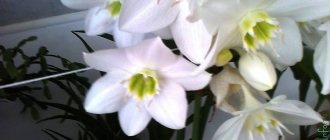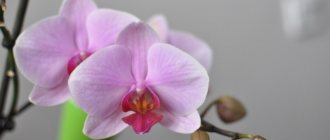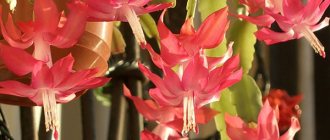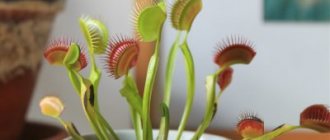European flower growers became acquainted with a gorgeous representative of tropical flora in the second quarter of the century before last.
The Eucharis flower, which arrived from the South American continent, quickly captivated the hearts of true connoisseurs of beauty, and the number of its devoted admirers increases year by year.
This is entirely facilitated by the decorative effect, delicate aroma and undemanding nature of the plant in terms of growing conditions. Informative! The greatest distribution of Eucharis species is observed in the humid areas of the Amazon River basin. Because of this circumstance, the plant is romantically called the “Amazon lily.”
Popular types, photos and names
Bulbous perennials of the genus Eucharis are classified according to taxonomic classification into the Amaryllis family. The genus contains approximately 2 dozen species that differ slightly from each other .
The fairly easy formation of hybrids between species and varieties within the genus and even within the family usually makes it difficult to determine the taxon of Eucharis specimens . In this matter, flower growers can be helped by knowing the fact that 6 types of flowers are most often cultivated indoors.
Eucharis grandiflora
The most popular type. Lily Eucharis grandiflora is distinguished by a dark green color and a significant size of the corollas - the diameter is around 12 cm. The leaves are succulent, elongated-oval in shape with a point.
Large flower shoots (up to 80 cm) bear umbrellas of inflorescences of 3–8 snow-white buds. Flowers with a persistent aroma .
Flowering may occur in December, May or August.
Eucharis white
The species is distinguished by the contour of the leaf blade, narrowed on both sides, and the brownish tint of the peduncle up to half a meter in height. Up to 10 buds are collected in an umbrella. Their diameter is up to 7 cm . Corolla with elongated petals.
Flowering occurs in October and March.
Eucharis Sandera
Specimens of this type of Amazonian lily have luxurious greenery. The arrow is thick, grows up to half a meter. The number of buds in an inflorescence varies from 2 to as many as a dozen .
If the plant develops a large corolla (about 10 cm in diameter), then few flowers bloom. And the smaller the size of the flower, the greater the number of them contained in the inflorescence. The corollas are particularly reminiscent of lily buds.
Flowering occurs in September and February.
Eucharis amazonica
The variety has wide-oval leaves of a dark tone. The flower arrow of slightly flattened outlines raises the corollas of the inflorescence by 70 cm. Each peduncle bears up to 6 buds . The blossomed corolla is about 12 cm in diameter and is shaped like a daffodil flower.
Eucharis Amazonis is the second most popular among gardeners.
Common types of indoor flowers
The indoor eucharis flower has several types, which differ in size and flowering time.
- Eucharis grandiflora is most often found on window sills. With good care, it is able to bloom three times a year: in late summer, winter and late spring.
- White Eucharis (Eucharis candida) has wider elliptical leaves, pointed at the tips. Their length can reach 40 cm and width - 15 cm. Peduncles with a brownish-green tint appear in early spring.
- Eucharis mastersii is more compact in size: the length of its leaves does not exceed 25 cm. It forms no more than two inflorescences on each arrow.
- Another compact species, Eucharis sanderi, has heart-shaped leaf bases. It blooms between February and April.
- Eucharis subedentata or, as it is sometimes called, callifruria toothless, is distinguished by its abundant flowering - 6-8 inflorescences per arrow. It is easily recognized by its oblong leaves of an unusual “triangular” shape, sitting on long grooved petioles.
Home care
Representatives of the Eucharis genus do not cause much trouble to their owners. Tropical beauties do not require the creation of special conditions in indoor culture.
They adapt quite easily to the microclimate of a certain room. With minimal care and compliance with all care regimens, the Amazon lily will have a decorative appearance and regularly form flower arrows.
Placement and lighting
Eucharis, when properly maintained, is capable of forming a rich leaf mass, growing significantly in volume. Therefore, even before purchasing a plant, you should provide a suitable place in the room, where nothing will interfere with the comfortable growth of the flower .
In relation to lighting conditions, the tropical guest is completely unpretentious. For harmonious growth and flowering, it needs intense, but not very bright light. The ideal location would be window sills on the west or east side.
Important! When placing Eucharis on southern windowsills, shading from bright midday rays is required during the active growing season. This will protect him from sunburn.
For plants on northern windows, it is necessary to consider illumination with fluorescent spectrum lamps.
Temperature
The flower feels great within the temperature limits of an ordinary apartment - thermometer readings of about +20°C are considered comfortable for it. But you should carefully monitor temperature changes, since sudden fluctuations are detrimental to Eucharis.
Attention! A prolonged decrease in temperature by several degrees is fraught with the formation of smaller buds. A drop in thermometer readings to +10°C can provoke the death of a specimen of the Amazon lily.
During the cold period, it is preferable to keep the flower at a temperature 2-3°C lower - this is necessary for Eucharis to maintain vitality at rest and further full flowering. But this rule does not apply to winter-blooming plants.
Watering and humidity
The watering regime of Eucharis differs from the moisture requirements of many tropical plants. Representatives of this genus prefer infrequent watering, subject to significant drying of the soil between successive procedures.
The Amazon lily should be kept according to the rule: it is better to dry it out a little than to overwater it significantly. Particular attention must be paid to stagnant moisture in the pot - if excess water is not drained from the pan, the roots of the tropical beauty may rot.
Important! After the end of the flowering period, watering is reduced to a minimum, giving the plant proper rest. Moisturizing can be resumed after the formation of young shoots.
To maintain comfortable humidity, it is recommended to regularly spray Eucharis. The exception to this schedule is the flowering time, since the buds may lose their decorative effect from drops of water.
Amazon lilies and wiping the dust with dry and wet cloths are useful.
Eucharis transplant
The Amazon lily has a negative attitude towards interference in its living space. Therefore, it is recommended to replace the pot and substrate no more often than after 3 years . For young specimens this period is reduced to a year.
The procedure is carried out in early spring and very carefully. An option with the transshipment method is possible. Be sure to consider the drainage system.
Soil and pot for Eucharis
For each transplant, you should choose a pot that is only slightly larger than the previous one, since the flowering of a tropical plant directly depends on its volume.
Advice! An Amazon lily may refuse to bloom in a pot that is too spacious, because all its strength will be spent on growing green mass. The pot must be taken based on the size of the bulb.
In this case, the pot must be deep enough for the bulb and roots and have good stability.
The soil for Eucharis should not only be nutritious, but also light, permeable, and with good aeration.
Feeding and fertilizers
It is recommended to feed the Amazon lily during the formation of buds, as well as throughout the stormy growing season, subject to visual monitoring of the need for the procedure.
You can fertilize with mineral preparations intended for plants in bloom. Method of application: after spilling the soil with water and in a liquid state.
Carefully! Under no circumstances should you feed recently transplanted Eucharis specimens or dormant plants. There is a danger of chemical burns.
This video talks about the features of caring for and growing Eucharis at home.
General information for the florist
Like any other flower grown at home, eucharis puts forward certain requirements for its habitat.
Table: optimal conditions for growing eucharis
| Options | Features and Requirements |
| Lighting | Intense but diffuse, shading may be required. |
| Temperature | Optimally in summer 20–25 degrees, in winter from 17 degrees. |
| Air humidity | Medium, without exceeding the desired level and excessive dryness. |
| Watering | Moderate, without overdrying or waterlogging the substrate. |
| Transfer | No more than once every 3 years, if necessary (if the bulbs fill the pot too tightly). |
| The soil | A nutrient mixture of different types of soil, compost, peat, organic fertilizers, sand; Drainage is required. |
| Reproduction | Basically - dividing the bulb; less often - with seeds (the method is very labor-intensive and not always effective). |
Now let's take a closer look at each step of caring for the plant.
Eucharis flowering
The beginning of flowering does not correspond to a specific seasonal period of time. Representatives of various species of Eucharis can bloom in any month of the year , which is due to their genetic predisposition.
In one year, plant specimens can form buds two or three times. Each flowering is followed by a short period of dormancy, and then growth again.
An individual corolla of an Amazonian lily remains decorative for almost a week , and the entire flowering can last about 3 weeks.
Beginning flower growers often have a question: why their Eucharis does not bloom. The answer is simple - most often the lack of flowering is caused by a too large pot .
One has only to replace the flowerpot with a less voluminous one, and the flowering of Eucharis will not be long in coming. The reason may be the absence of a dormant period (you should take care of the conditions) or the single status of the bulb (plant several in one pot or wait until the children form) .
This video explains how to care for Eucharis and what needs to be done for the lily to bloom.
Description
Eucharis belongs to the Amaryllidaceae family.
The plant belongs to the category of bulbous flowers, since it has small bulbs completely covered with golden scales. In adult Eucharis, it is rare to see bulbs whose diameter exceeds 60 mm. The plant can also be found in the wild . Typically, wild varieties have only 2-4 leaves, while indoor varieties have a significantly larger number of leaf blades. The reason for this phenomenon is the fact that when planting eucharis in a pot at home, several bulbs are used at once.
This planting helps to grow a more lush and spectacular plant, since it has more leaves. And bulbs bloom more readily in a pot if there are several of these plant elements in it at once. Eucharis flowers are showy, white with a golden crown. Their aroma is subtle, barely perceptible.
The leaf plates of Eucharis are quite large: they are oval in shape and reach 35-45 cm in length and 15-20 cm in width. The plates become pointed at the ends. The leaves are attached to the bulbs using elongated petioles (each can reach 25-30 cm in length). The surface of the leaf is wrinkled, with a glossy sheen and noticeable longitudinal veins of a dark green color.
Important! Eucharis leaves do not lose their decorative effect for many years, although over time they may fall off, allowing young shoots to take their place.
Eucharis in winter: dormancy and flowering
Usually during the cold season, plants have a rest period. In varieties of Amazonian lilies, this phenomenon is not very clearly visible due to the presence of rich leaf mass , which is not shed by the plant for the winter.
The resting phase of Eucharis can be judged by the cessation of flowering. At this moment, you should lower the temperature and watering, creating comfortable conditions for the Eucharis flower to rest.
But representatives of some species of Eucharis bloom precisely in the winter months. Standard care should continue for them. It is especially necessary to monitor air humidity, which is reduced by central heating devices. It is better to place plants away from radiators, and use the whole range of methods to increase humidity for them.
Why doesn't it bloom?
- Sometimes gardeners are faced with the fact that eucharis does not bloom at all, but only forms green leaf blades.
In this case, you need to pay attention to the watering regime. The plant can be overwatered and overfed, so that it cannot go into the resting phase and continues to actively grow green mass. Important! Priority growth of green mass in a flower may be associated with an excess of nitrogen fertilizers. - Another reason why the Amazon lily does not want to bloom is that the pot is too spacious and there are not enough bulbs in it. So when planting, try to fit several children at once (up to 7) in one container so that flowering is more abundant and frequent.
- In some cases, the absence of flower stalks may be due to improper care of the plant.
Planting several Eucharis bulbs in one pot
As you know, a single Amazon lily bulb will not form a flower arrow until a sufficient number of children grow on it - this is a genetic feature of the plant.
Interesting! It is possible to obtain a decorative specimen of Eucharis and speed up the blooming of its flowers by planting several bulbs in a flowerpot.
This procedure uses a wide and stable vessel in which several bulbs can be placed, leaving their tops above the soil surface. The number of bulbs planted depends on the volume of the pot.
What kind of soil is required for eucharis?
If you prefer to use store-bought soil, then choose those mixtures that are intended for amaryllis, hipeastrum, vallotta and some other bulbous plants.
Eucharis is an inhabitant of the tropics; in its natural environment it grows in soils with good moisture and air permeability, rich in organic matter. When compiling the soil yourself, this must be taken into account; this is the only way you will provide good nutrition for the eucharis. Home care also includes proper preparation of soil for planting or replanting. The approximate ratio of the components is as follows: leaf soil/humus/river sand - 2/1/1. The soil reaction should be slightly acidic; adding peat in small quantities (0.5 parts) is welcome. Do not forget about good drainage to ensure the drainage of excess moisture and access of air to the roots. You can use expanded clay, coconut or walnut shells.
Reproduction
Eucharis Amazonian lily in indoor culture can be propagated by vegetative (bulbs) and sexual (seeds) methods.
Bulbs
This method is most acceptable for gardeners and is quite quick to implement. Used mainly when transplanting adult Eucharis specimens .
By the age of three, several children grow on the bulb of Eucharis. For propagation, the mother plant is carefully removed from the pot. Formed children are separated from the main bulb , trying not to break the roots.
Each resulting shoot is planted in its own vessel or in groups - in one common flowerpot. Next, standard care is carried out.
Small onions are not touched; they must grow to a certain size . The mother bulb with the remaining children is transplanted into a new flowerpot, changing the substrate.
When propagated by bulbs, a new plant is capable of blooming the very next year, and under favorable conditions it can produce a peduncle almost instantly in the same period.
Seminal
Obtaining young specimens of Eucharis by seed method in home culture is used only by flower growers with solid experience and experience in the process of some experiments.
to obtain Eucharis seeds in home collections only through artificial pollination of the pistils of the corollas of the Amazon lily. After fertilization, the seed pod begins to grow. It is cut off when it dries completely and cracks appear on it.
The finished seeds are sown in a mini-greenhouse. You have to wait up to 20 days before the seedlings hatch. When the seedlings produce their third leaf, they can be transplanted into a pot - preferably several at a time.
When propagating from seeds, the first flowers are expected to appear for about 5 years.
Eucharis transplantation - step-by-step recommendations
Transferring eucharis into a new container occurs without destroying the earthen clod and is not traumatic for the plant.
The earthen lump is not disturbed
Comparison of pot sizes
Division by bulbs
If a flower is replanted for the purpose of division, then it is better to wash off the soil from the roots with water - this way there is less risk of damaging the fragile bulbs. The baby, with a diameter of 4 cm, is carefully separated from the mother bulb, making sure to cover the broken areas with charcoal dust or ash.
- Drainage is poured into the bottom of the pot in a layer of 2-3 cm. Then the container is filled one third or half with prepared soil.
- The bulbs are immersed in a pot and covered with substrate. Bulbs in a state of complete dormancy are covered with soil to a depth of 2 cm, bulbs with green sprouts are placed at a depth of 5 cm from the surface.
- After planting, water the soil well, soaking the entire volume of the pot. When the soil settles after watering, soil is added to the pot.
In the first couple of weeks after transplanting, water the plant infrequently, keeping the soil slightly moist. For adult eucharis, maintain high air humidity by wiping the leaves with a damp sponge.
Emerging problems
The Amazon lily is a fairly resistant plant to various troubles. All Eucharis problems occur with specimens weakened due to care errors and are mostly solved by correcting maintenance methods.
- Eucharis does not bloom - what to do? – An analysis of the content system will help solve the problem. 1. Refusal to flower is possible if Eucharis does not have winter rest. – Care should be taken to create suitable conditions. 2. The plant is not able to bloom in a large pot . – It is necessary to transplant it into a vessel of suitable volume. 3. Only an onion with children can form an arrow. – This is a genetic feature and you just need to wait.
- Eucharis leaves turn yellow and die. – Consequences of violation of care regimes: sharp alternation of overdrying and overwatering of soil, exposure to drafts, strong temperatures fluctuations. – It is necessary to bring care methods to normal and carefully adhere to them
. - Why do Eucharis have limp leaves? – There are several reasons that caused this problem: cold conditions, dry soil, damage to the root system during replanting and drafts. – Care regimens should be reviewed and adjusted.
- The most common diseases are rot and spotting as a result of soil overflow. – It is necessary to adjust the watering and treat the plant with a fungicide.
- Parasites of Eucharis include spider mites, scale insects and thrips. – The plant must be quarantined and treated with an insecticide .
This video talks about the problem with Eucharis and shows its yellowed leaves
Diseases and pests
Eucharis is resistant to most pests. When kept outdoors in summer, it can be affected by aphids. In rare cases, a plant may be “attacked” by a spider or root mite. In the first case, use any systemic insecticides, for example, Aktara, Konfidor. In the second, acaricides such as Neoron, Kleschevit or Fitoverm will help get rid of parasites.
The roots of weakened or rotting bulbs can be gnawed by fungus gnat larvae. They appear only when agricultural practices are violated and do not harm healthy plants. In this case, it is important to concentrate not on getting rid of insects, but on preventing further decay.
The most dangerous of the fungal diseases that can affect eucharis is fusarium or red rot. If it appears, the bulb is removed from the soil, the rotten parts are cut off and kept in strong fungicides, such as Fundazol or Copper Oxide. But it is easier to prevent this disease by avoiding coolness and excessive dampness.
Signs and superstitions associated with Eucharis
In all countries, Eucharis is bred in indoor collections as a beneficial specimen with positive energy. He is credited with the ability to have a beneficial effect on people's state of mind , absorb negativity, and enhance hard work and curiosity.
The plant reveals the hidden intuitive abilities of a person.
It is considered a protective talisman for unmarried women.
Things started during the flowering period of Eucharis will be brought to a successful conclusion.
If a flower living in an apartment withers suddenly and quickly , it means that it has warded off a terrible disease from the family, taking it upon itself.
If you weave a blooming Amazonian lily into a wedding wreath, this promises the future family protection from quarrels and envious people.
Choosing the right place
If you don't have a lot of direct sunlight in your home, then you can safely choose eucharis. Care at home (reviews confirm this) is quite simple. The plant is not too demanding. However, it is better to immediately choose the right place for the Amazon lily. Firstly, eucharis is a fairly large plant and will require a lot of space, so it is often grown in floor flowerpots. Secondly, this flower grows mainly in the lower tier of the tropical forest, the light reaches it, but for the most part it is diffused. Direct sunlight on Amazon lilies is contraindicated; they will simply burn the leaves and flowers. The most optimal and favorable option is bright, diffused sunlight. However, eucharis still tolerates slight shading and will grow well even opposite a north window.
The most optimal temperature regime during flowering and active growing season is from 24 to 28 °C. In winter, the rates drop. After flowering ends, the so-called dormant period begins. It is not as clearly defined as, for example, in succulents or cacti, but it still occurs. At this time, you must avoid sudden changes in temperature and maintain it within 17-18 °C, but not lower than 7-8 °C, otherwise you will destroy the eucharis. Home care (rest period) described above should be carried out if you want abundant and long-lasting flowering. If the plant does not rest, then over time (at best) it shreds. Flowering will be minimal.











